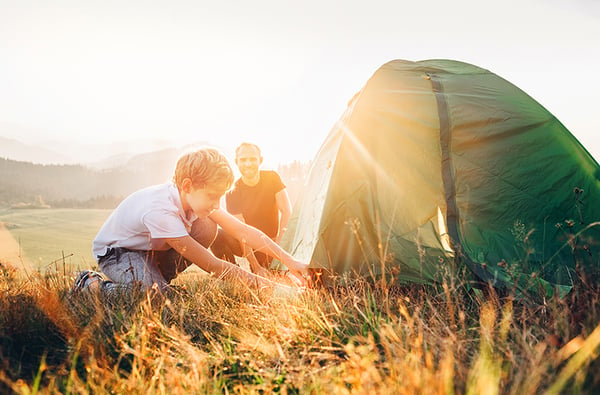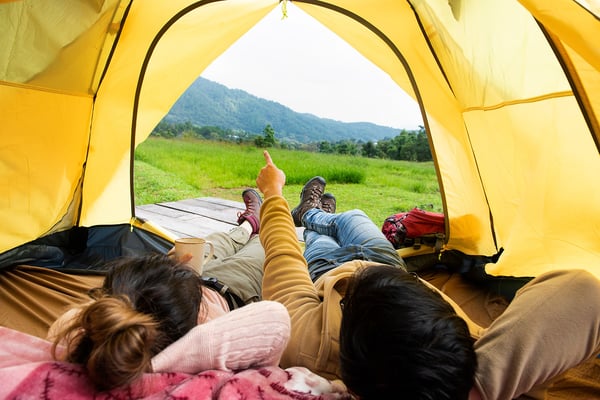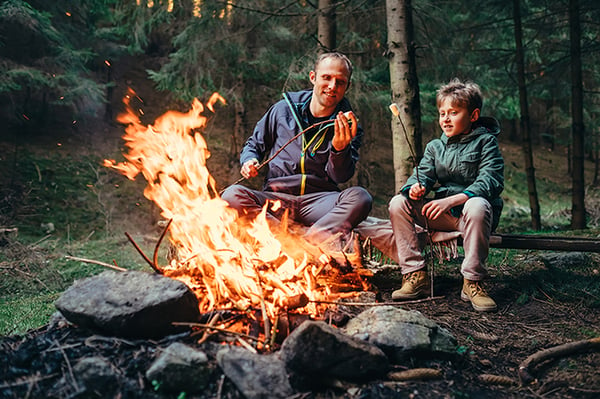As the season begins, we’re sure that the idea of camping with your friends and family has already crossed your mind. After all, Saskatchewan is truly a paradise when it comes to summer camping.
However, if you’re new to the notion of camping, things can turn out to be quite overwhelming.
The process of pitching a tent, for instance, might look challenging to beginners. However, it can be mastered with patience and practice. Here are a few tips to set up camp like a professional.
Download the Ultimate Guide to Summer Camping
1. Look for the flattest spot
When looking for a spot to pitch your tent, try to choose the flattest possible spot available. Doing so will ensure that your tent is always stable and you’re able to enjoy a good sleep.

If, however, you’re not able to find a flat spot and are only able to find an inclined one, make sure that your head always remains on the elevated part of the ground.
Furthermore, always be prepared in case it rains as well. Jay Brown, an avid Saskatchewan hiker, feels that’s one of the most common mistakes people make.
He says, “a common mistake that people make is not looking for the highest spot at the campsite. Due to this, if they set up their tents at a lower spot then the area might flood up if, and when, it rains.”
2. Clean the area around your spot
Clean the area where you plan to pitch your tent. Keep an eye out for sharp rocks or twigs as those can damage the base of your tent. You can either remove them or move your tent to a better location.

It’s also a good practice to be aware of the area surrounding your tent. If you notice a lot of fallen branches or twigs, it could be a sign that the trees nearby shed a lot.
Another important thing to note is water. Setting up a tent next to a puddle of water can attract bugs and flies, which is never pleasant.
It can also mean that the area tends to flood up whenever it rains. Therefore, it might be better to pitch your tent elsewhere.
3. Stake your tent
Even though weather forecasts give us a good idea about how the weather will be for the duration of your camping trip, you never know when a sudden gush of wind might uproot your tent.
Therefore, always stake your tent irrespective of the weather conditions.
A tent stake is a spike made from wood, metal, or plastic that is used to hold a tent firmly to the ground. It can be hooked to a tent’s ropes and then be pushed or driven into the ground to ensure stability.
4. Store things properly inside
Just because the tent will be your personal space, it doesn’t mean that animals can’t get in. Mice and other four-legged creatures can easily get into your tent to investigate what you have.
Therefore, store things like food and smaller items (lotions, toothpaste, etc.) properly because you never know what animals may smell and want to investigate.
Saskatchewan also has a healthy population of black bears who look for food in the summers and are attracted to new scents. It’s for these reasons that campers often see bears wander through their campgrounds.
According to the Government of Saskatchewan, “bears lose their natural fear of humans once they have been fed by them. When bears start to associate their food with humans, they become a nuisance and a public safety concern.”
CAA PRO TIP: Avoid keeping food in your tent. Instead, store it along with other cooking items in your car or storage bins. Proper food storage, cooking methods, and garbage handling are essential for safe camping in bear country.
5. Set up your sleeping area
Once you have finished setting up the tent, the next step is to set up your sleeping area.
Begin with first inflating your sleeping pads and laying them down on the base of the tent. Depending on your preferences, you can also choose to purchase self-inflating sleeping pads.

Then it’s time to place your sleeping bags on top of the pads. Once that is done, place your pillows at the head of the sleeping bag and have your clothing and other items stowed by your feet.
Keep a bag of necessary items like headphones, toiletries, phones, books, etc. next to your pillow for easy access when you’re all tucked in.
6. Always stay dry and warm
While camping, it’s important that you always maintain optimum body temperature. A great way to ensure that is to pack well when it comes to clothes.
Always have some nice warm clothing handy if the weather turns cool. Pack extra insulated jackets as you never know when it might get cold at night or around the campfire.
In case your trip happens to be during cold or wet weather conditions, check out our detailed blog on how to tackle those conditions.
7. Electricity hookups
Even though the idea of camping means getting away from the hustle of everyday life and leaving the luxuries of home behind, living without electricity can be a big challenge.
The good news is that you don’t have to. Most front country campgrounds in Saskatchewan offer campers the luxury of an electrical hookup so you can power smaller devices.
It’s just a matter of finding out which ones do, and which ones don’t. The Saskatchewan Parks’ online camping system is a great source to get that information.
8. Lighting a fire
The first and foremost rule when it comes to building a campfire is that it must only be built at a designated fire pit that is well away from any type of plantation, grass, or trees.
In addition to that, always keep a bucket of water handy nearby as a safety measure.
To build the fire, you can either use some store-bought fire starters, old newspapers, or cardboard eggshell cartons as they easily help the firewood catch fire. Do not use anything made of plastic.
If you find kindling (small sticks or twigs) around your fire pit area, you can also use that to start the fire. Keep adding more firewood to the pit to keep the fire going as long as you want.

At the end of the night, whenever you leave the site, always be sure the fire is fully out.
To put out the fire, gradually start pouring water on the fire and stir the burnt wood around. You must pour enough water so that the fire is completely extinguished, but not so much that it floods the fire pit and makes it impossible for use in the future.
When it comes to storing firewood, always store it in a location where it remains dry. This can be either under (or inside) your car or in a plastic bag.
CAA PRO TIP -- Occasionally due to extreme fire hazards, the Ministry of Parks, Culture and Sport will issue restrictions on open fires in provincial parks and recreation sites. Always check beforehand with the park authorities about existing fire bans. You can also visit the Saskatchewan Parks website for info.
Download the Ultimate Camping Guide
The secret behind every great camping trip is to be prepared for it. And what best way to be prepared for your trip than to equip yourself with the Ultimate Guide to Summer Camping.
Grab your copy today and get detailed camping insights, learn about the different types of camping, and get access to secrets from experienced campers who have learned through experience.
Know everything about summer camping in Saskatchewan and set up camp with confidence.


.png?width=600&name=1500%20x%20500%20Ultimate%20Guide%20Cover%20Banner%20(Right).png)